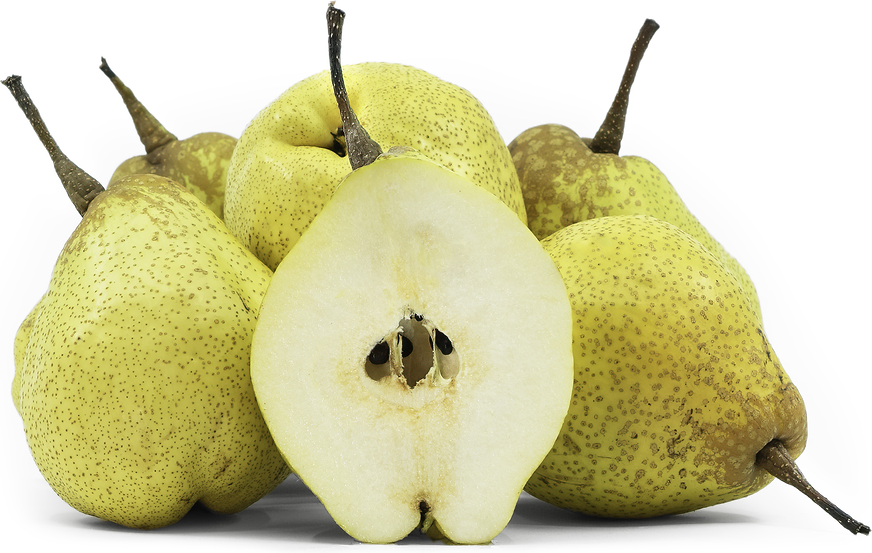


Tsu-Li Asian Pears
Estimated Inventory, lb : 0
Description/Taste
Tsu Li pears are large, elongated fruits, averaging 7 to 8 centimeters in diameter, and generally appear in an oval to pyriform shape. The pears have a distinct, bulbous base, tapering slightly to a short, curved neck, and attached to the neck, there is a thick, tall, and fibrous, dark brown stem. The skin is firm, semi-waxy, and coarse, ranging from green to yellow, and is covered in a brown russet with raised lenticels. Underneath the surface, the white flesh is tinged with yellow-brown hues and has a dense, juicy, grainy, and crisp consistency. Tsu Li pears have a faint, pineapple-like aroma and are sweet, balanced with subtle tart and floral notes.
Seasons/Availability
Tsu Li pears are available in limited quantities in the fall.
Current Facts
Tsu Li pears, botanically classified as Pyrus pyrifolia, are a late-season, heirloom variety belonging to the Rosaceae family. The ancient fruit is native to China, where it was once a famous pear for fresh eating, and is highly favored for its crisp, sweet, and juicy flesh. In the modern-day, Tsu Li pears have struggled to expand in cultivation as new Asian pear varieties with improved qualities have become the favored fruits for commercial growth. Tsu Li pears are still cultivated in select regions of China to preserve the variety. In California, the cultivar is grown for its resistance to fire-blight, a common disease that can significantly affect pear crops. Despite their favorable disease resistance, Tsu Li pear trees are also notorious for low productivity and a slow-growth rate, causing the variety to become a specialty fruit only grown in small quantities.
Nutritional Value
Tsu Li pears are an excellent source of fiber to stimulate the digestive tract and are a good source of vitamin C, an antioxidant that can strengthen the immune system and reduce inflammation within the body. The fruits also contain vitamin K, a nutrient that helps maintain healthy blood functioning and provide lower amounts of potassium to regulate fluid levels.
Applications
Tsu Li pears are best suited for raw applications as their crunchy texture and sweet flavor is showcased when consumed fresh, out-of-hand. It is important to note that the pear will remain crunchy and will not continue to ripen once it is harvested. Tsu Li pears can be chilled, sliced, and served as a snack in between meals, sliced and tossed into green salads, cubed for fruit salads, displayed on cheese boards, grated into coleslaw, or cut into stir-fries. They are also considered a dessert pear and can be eaten fresh after a meal or stewed for added flavor. Beyond fresh uses, the firm flesh of Tsu Li pears can be utilized in grilled, poached, baked, and roasted applications. The fruits can be chopped and added to vegetable bowls, sautéed with cinnamon to serve atop pork chops, slow-cooked to make a sweet sauce for short ribs, or hollowed out and stuffed with dried fruit and nuts. They can also be thinly sliced and floated on top of soups. Tsu Li pears complement other ingredients such as cheeses, including blue, manchego, and gorgonzola, nuts such as almonds and cashews, jujubes, meats such as pork, duck, poultry, and beef, aromatics such as red onion, scallions, and garlic, leafy greens, shiso, honey, and miso. Tsu Li pears have extended storage capabilities and can keep up to six months in professional cold storage. In home kitchens, the pears can be stored for at least three weeks in the refrigerator's crisper drawer.
Ethnic/Cultural Info
During the California Gold Rush in the mid 19th century, many different Asian pear varieties were brought with Chinese miners to California in their search for gold. The seeds were planted along streams, in homesteads, near settlements, and beside stagecoach stops as a source of food, and as more miners immigrated from Asia to join the movement, branches from additional varieties were also carried and planted into the California landscape. In the present day, many of these trees are still growing in obscure locations throughout northern California, but due to the lack of historical knowledge, the majority of the trees are being lost to commercial development. Bob Cantisano, affectionately known as “amigo” among northern California botanists, has been researching these historical gold rush fruits to preserve the trees from being cut down. Cantisano has conserved several pear trees throughout Nevada County, including a tree situated between a gas station and a community hall, and uses these trees to educate residents on the importance of older fruit varieties. It is believed that some of the trees are over 120 years in age, and Cantisano hopes to study these trees to use them as a resource for improved California fruit cultivation.
Geography/History
Tsu Li pears are native to Tse County in the Shandong Province of China and have been cultivated for thousands of years. The ancient heirloom variety was once a well-known pear in Shandong, favored for its crisp texture and extended storage capabilities, but over time, it has been overshadowed by new Asian pear varieties with improved growth characteristics. Today Tsu Li pears are still grown in the Penglai, Chucheng, and Laiyang Districts of Shandong and are also cultivated on a small scale in Japan, Siberia, Korea, and the United States. The Tsu Li pears featured in the photograph above were grown at Penryn Orchards, located in Northern California.
Recipe Ideas
Recipes that include Tsu-Li Asian Pears. One
Podcasts




